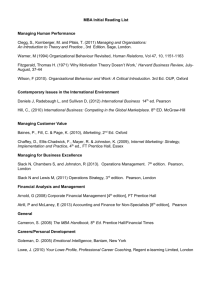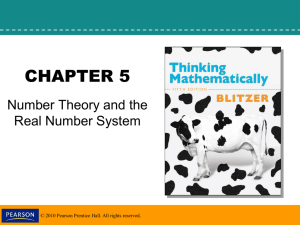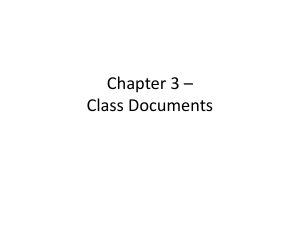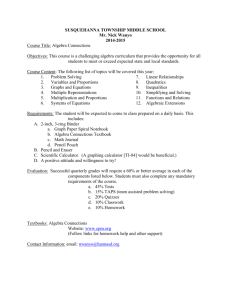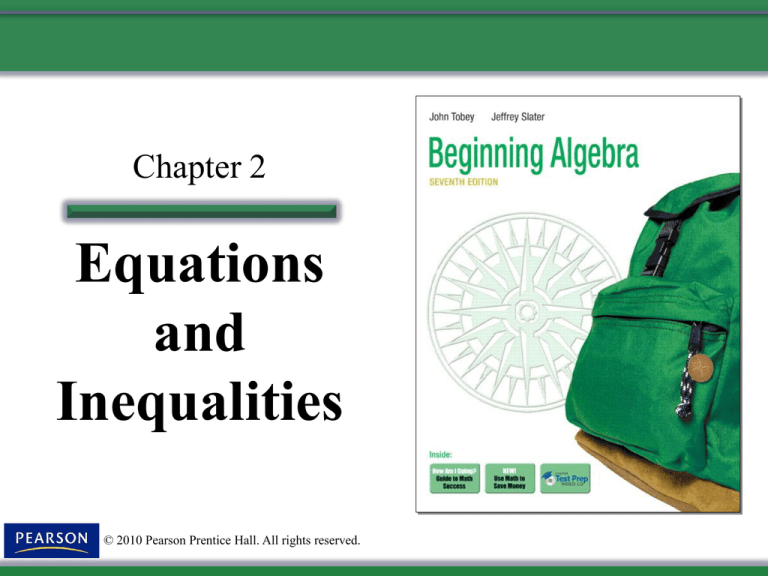
Chapter 2
Equations
and
Inequalities
© 2010 Pearson Prentice Hall. All rights reserved.
§ 2.1
The Addition Principle of
Equality
© 2010 Pearson Prentice Hall. All rights reserved.
Equations
An equation uses an equal sign (=) and indicates that
two expressions are equal.
6 + 7 = 13
An equation always
has an equal sign.
6+7=x
The solution of an equation
is the number which makes
the equation true.
6 + 7 = 13
13 is the solution for
this equation since it
makes 6 + 7 = x true.
© 2010 Pearson Prentice Hall. All rights reserved.
Tobey & Slater, Beginning Algebra, 7e
3
Equivalent Equations
Equations that have exactly the same solution are
called equivalent equations.
6 + x = 13
x=7
7 is the solution to the
equation 6 + x = 13.
The process of finding all solutions of an equation is
called solving the equation.
© 2010 Pearson Prentice Hall. All rights reserved.
Tobey & Slater, Beginning Algebra, 7e
4
The Addition Principle
The Addition Principal
If the same number is added to both sides of an
equation, the results on both sides are equal in value.
6 + x = 13
We need to find
the value of x.
6 + x + (6) = 13 + (6)
Adding (6) to both sides of the equation
will maintain the balance of the equation.
x=7
Left side
Right side
Solution to
the equation.
© 2010 Pearson Prentice Hall. All rights reserved.
Tobey & Slater, Beginning Algebra, 7e
5
Solving Equations of the Form x + b = c
Example:
Solve a 6.2 = 3.5.
a 6.2 = 3.5
6.2 is the opposite of 6.2.
Add 6.2 to both sides of the equation.
a 6.2 + (6.2) = 3.5 + (6.2)
a = 2.7
Check your answer in
the original equation.
(2.7) 6.2 = 3.5
© 2010 Pearson Prentice Hall. All rights reserved.
Tobey & Slater, Beginning Algebra, 7e
6
Solving Equations of the Form x + b = c
Example:
Solve for c.
3c 8 = 2c 15
3c 8 + 8 = 2c 15 + 8
3c = 2c 7
3c + (2c) = 2c 7 + (2c)
c = 7
3(7) 8 = 2(7) 15
21 8 = 14 15
Add 8 to both sides
of the equation.
Add 2c to both sides
of the equation.
Check your answer in
the original equation.
29 = 29
© 2010 Pearson Prentice Hall. All rights reserved.
Tobey & Slater, Beginning Algebra, 7e
7
Solving Equations of the Form x + b = c
Example:
Find the value of y that satisfies the equation
Be sure to check
your answer in
the original
equation.
2
1 3
y
5
2 10
2 2
1 5 3
y
5 2
2 5 10
4
5 3
y
10
10 10
4
2
y
10
10
2
1
y
10
5
© 2010 Pearson Prentice Hall. All rights reserved.
The LCD is 10.
Simplify.
Simplify.
Add
4
to both sides of
10
the equation and simplify.
Tobey & Slater, Beginning Algebra, 7e
8
§ 2.2
The Multiplication
Principle of Equality
© 2010 Pearson Prentice Hall. All rights reserved.
Multiplication Principle of Equality
Multiplication Principle
If both sides of an equation are multiplied by the same
nonzero number, the results on both sides are equal in value.
We need to find
the value of w.
1
w 3
7
7 1
7
w 3
1 7
1
w = 21
Multiplying both sides of the equation by 7
1
will maintain the balance of the equation.
Solution to
the equation.
© 2010 Pearson Prentice Hall. All rights reserved.
×7
×7
Left side
Right side
Tobey & Slater, Beginning Algebra, 7e
10
Division Principle of Equality
Division Principle
If both sides of an equation are divided by the same nonzero
number, the results on both sides are equal in value.
We need to find
the value of z.
21z 273
21z 273
21
21
z = 13
Dividing both sides of the equation by 21
will maintain the balance of the equation.
Solution to
the equation
© 2010 Pearson Prentice Hall. All rights reserved.
÷ 21
÷ 21
Left side
Right side
Tobey & Slater, Beginning Algebra, 7e
11
Solving Equations of the Form ax = b
Example:
Solve for y.
2.1y 0.3
2.1y
0.3
Divide both sides of the equation by 2.1.
2.1
2.1
1
y
7
1
This is the same as multiplying each side by 2.1 ,
which is the multiplicative inverse of 2.1.
1
For any nonzero number a, the multiplicative inverse of a is ,
a
1
and the multiplicative inverse of is a.
a
© 2010 Pearson Prentice Hall. All rights reserved.
Tobey & Slater, Beginning Algebra, 7e
12
1
Solving Equations of the Form x = b
a
Example:
Solve for q.
1
4
q
7
7
7 1
4 7
q
1 7
7 1
4 7
q
7 1
7
Multiply both sides of the equation by .
1
q 4
1 4
4
7 1
7
© 2010 Pearson Prentice Hall. All rights reserved.
Check your answer in
the original equation.
Tobey & Slater, Beginning Algebra, 7e
13
§ 2.3
Using the Addition &
Multiplication Principles
Together
© 2010 Pearson Prentice Hall. All rights reserved.
Solving Equations of the Form ax + b = c
Example:
Solve for w.
3w 9 = 24
3w 9 + 9 = 24 + 9
3w = 15
3w
15
3
3
w = 5
3(5) 9 = 24
Use the division principle to
divide both sides of the equation
by 3.
Check your answer in
the original equation.
15 9 = 24
24 = 24
Use the addition principle to add
9 to both sides of the equation.
© 2010 Pearson Prentice Hall. All rights reserved.
Tobey & Slater, Beginning Algebra, 7e
15
Equations with Variables on Both Sides
Example:
Solve for c.
9c + 5 = 3c 13
9c + 5 + (5) = 3c 13 + (5)
9c = 3c 18
9c + (3c) = 3c 18 + (3c)
6c = 18
6c
18
6
6
c = 3
Check your answer in
the original equation.
© 2010 Pearson Prentice Hall. All rights reserved.
Add 5 to both sides
of the equation.
Add (3c) to both
sides of the equation.
Divide both sides of
the equation by 6.
9(3) + 5 = 3(3) 13
27 + 5 = 9 13
22 = 22
Tobey & Slater, Beginning Algebra, 7e
16
Equations with Variables on Both Sides
Example:
Solve for x.
5 + 7x 19 = 8x 6 + 3x
7x 14 = 11x 6
7x 14 + 14 = 11x 6 + 14
Add like terms on both
sides of the equation.
Add 14 to both sides
of the equation.
7x = 11x + 8
7x 11x = 11x + 8 11x
Add (11x) to both
sides of the equation.
4x = 8
4x
8
4 4
x 2
© 2010 Pearson Prentice Hall. All rights reserved.
Divide both sides of
the equation by 4.
Be sure to check your answer!
Tobey & Slater, Beginning Algebra, 7e
17
Solving Equations with Parentheses
Example:
Solve for d.
5d 6(d + 1) = 2d 6
5d 6d + (6) = 2d 6
d + (6) = 2d 6
Distribute to remove the parentheses.
Add like terms.
d + (6) + 6 = 2d 6 + 6 Add 6 to both sides of the equation.
d = 2d
d 2d = 2d 2d
3d = 0
Simplify.
Add (2d) to both sides of the equation.
Simplify.
d=0
Be sure to check your answer!
© 2010 Pearson Prentice Hall. All rights reserved.
Tobey & Slater, Beginning Algebra, 7e
18
§ 2.4
Solving Equations with
Fractions
© 2010 Pearson Prentice Hall. All rights reserved.
Solving Equations with Fractions
Example:
Solve for a.
15 1 a 1 a
2
4
4(15) 4 1 a 4 1 a
2
4
60 2a a
The LCD is 4.
Simplify.
60 3a
Add 2a to both sides.
20 a
Divide both sides by 3.
Check your answer in
the original equation.
© 2010 Pearson Prentice Hall. All rights reserved.
15 1 (20) 1 (20)
2
4
15 10 5
55
Tobey & Slater, Beginning Algebra, 7e
20
Solving Equations with Fractions
Example:
Solve for x.
2 ( x 4) 6 1 (3x 2) 1
3
4
2x 8 6 3x 1 1
Distribute to remove parentheses.
3 3
4 2
12 2 x 12 8 12 6 12 3x 12 1 12 1
3
3
4
2
The LCD is 12.
8x 32 72 9x 6 12
Simplify.
8x 32 66 9 x
Combine like terms.
17x 34
x2
© 2010 Pearson Prentice Hall. All rights reserved.
Add 9x and subtract 32 from each side.
Divide both sides by 17.
Tobey & Slater, Beginning Algebra, 7e
21
Procedure to Solve Equations
Procedure to Solve Equations
1.
2.
3.
4.
5.
6.
7.
8.
Remove any parentheses.
If fractions exist, multiply all terms on both sides by the LCD of
the fractions.
Combine like terms, if possible.
Add or subtract terms on both sides of the equation to get all
terms with the variable on one side of the equation.
Add or subtract a constant value on both sides of the equation to
get all terms not containing the variable on the other side of the
equation.
Divide both sides of the equation by the coefficient of the
variable.
Simplify the solution, if possible.
Check your solution.
© 2010 Pearson Prentice Hall. All rights reserved.
Tobey & Slater, Beginning Algebra, 7e
22
Equations with No Solution
Example:
Solve for y.
– 1 + 5(y – 2) = 12y + 3 – 7y
– 1 + 5y – 10 = 12y + 3 – 7y
5y – 11 = 5y + 3
– 11 = 3
Distribute to remove the parentheses.
Combine like terms.
Subtract 5y from both sides.
False!
This equation has no solution.
© 2010 Pearson Prentice Hall. All rights reserved.
Tobey & Slater, Beginning Algebra, 7e
23
Equations with Infinite Solutions
Example:
Solve for z.
7(z + 4) – 10 = 3z + 20 + 4z – 2
7z + 28 – 10 = 3z + 20 + 4z – 2
7z + 18 = 7z + 18
18 = 18
Distribute to remove the parentheses.
Combine like terms.
Subtract 7z from both sides.
Always true.
This equation has an infinite number of solutions.
© 2010 Pearson Prentice Hall. All rights reserved.
Tobey & Slater, Beginning Algebra, 7e
24
§ 2.5
Formulas
© 2010 Pearson Prentice Hall. All rights reserved.
Solving a Formula for a Specified Value
bh
A
.
The formula for the area of a triangle is
2
Example:
If the area of a triangle is 66 inches, and the base is 8
inches, find the height of the triangle.
A = 66
(8)h
2
132 8h
66
in2
h=?
16.5 h
b = 8 in
Substitute in the values.
Multiply both sides by 2.
Divide both sides by 8.
The height of the triangle is 16.5 inches.
© 2010 Pearson Prentice Hall. All rights reserved.
Tobey & Slater, Beginning Algebra, 7e
26
Solving a Formula for a Specified Value
Procedure to Solve a Formula for a Specified Value
1.
2.
3.
4.
5.
6.
7.
Remove any parentheses.
If fractions exist, multiply all terms on both sides by the LCD of
the fractions.
Combine like terms, if possible.
Add or subtract terms on both sides of the equation to get all
terms with the variable on one side of the equation.
Add or subtract a constant value on both sides of the equation to
get all terms not containing the variable on the other side of the
equation.
Divide both sides of the equation by the coefficient of the
variable.
Simplify the solution, if possible.
© 2010 Pearson Prentice Hall. All rights reserved.
Tobey & Slater, Beginning Algebra, 7e
27
Solving a Formula for a Specified Value
The formula for the area of a trapezoid is A
h(a b)
.
2
Example:
Solve the formula for b.
h(a b)
2
2 A h(a b)
A
2A
ab
h
2A
a b
h
Multiply both sides by 2.
Divide both sides by h.
Subtract a from both sides.
The formula is now solved for b.
© 2010 Pearson Prentice Hall. All rights reserved.
Tobey & Slater, Beginning Algebra, 7e
28

